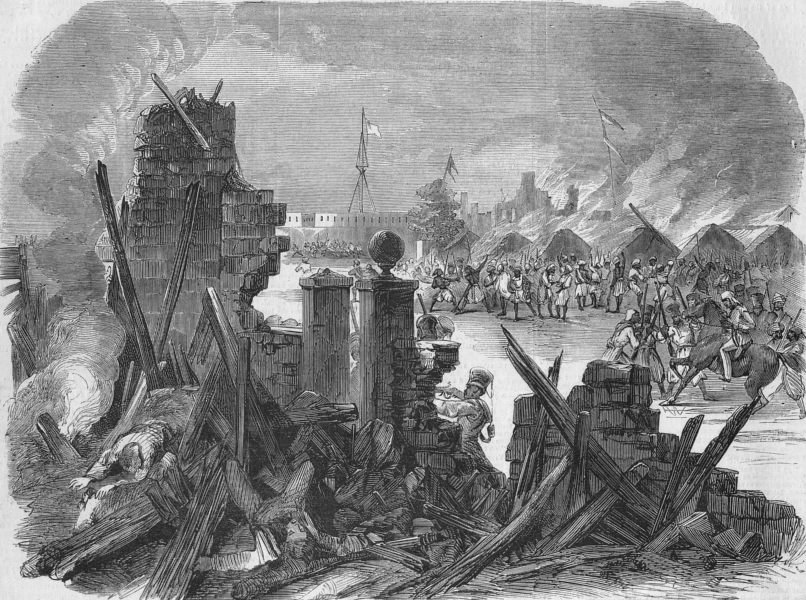The Sepoy revolt at Meerut," from the Illustrated London News, 1857

Summary of the Event
-
The Sepoy Rebellion was an uprising that occurred in 1857-1859 between the British/EIC and Indians.
-
There were many causes, but the overall goal was to reduce British/EIC control over India.
-
The rebellion united many different demographics in India that were previously differentiated between.
-
Women played a large role both in the fighting and propaganda aspects of the Rebellion.
-
The rebellion ended in the relinquishment of the EIC’s control in India and shifted it to the British Crown.
Summary by Alyssa Selverian (March 2023)
Some of the causes of the Rebellion include:
- Britain's/British East India Company's efforts to gain economic and political control of the subcontinent. This included outlawing cultural practices such as sati and child marriage.
- Fears of forced Christian conversion by the British
- Uneven ratio of Indian soldiers-to-Indian leadership in military forces (i.e., despite making up majority of the cavalry, most commanders were British)
- Poor terms of service and pensions, bad pay, lack of promotion, and increased cultural and racial insensitivity by British officers (e.g., greasing (Enfield) rifles with cow and pig fat and forcing soldiers to use their mouths to open cartridges, despite the fact that cows were considered holy by Hindus and pigs were considered unclean (Haram) by Muslims)
- The EIC imposing heavy taxes on locals (including land taxation)
- The resumption of tax-free land and confiscation of jagirs
- Confiscation of land from the landlords -> land was auctioned off to merchants and moneylenders -> ability to speculate in British land sales and drive out the most vulnerable peasant farmers
Further Resource on Causes/Summaries:
Article: Causes of the 1857 Revolt
Article/Video: Revolt of 1857 - First War of Independence Against British
Article: Why Did the Indian Mutiny Happen
Video: Revolt of 1857 - Major Causes | Political Causes | Administrative | Discontent among Sepoys
Links Page (Multi-Media): India and the 1857 Sepoy Rebellion
Video: Sepoy Mutiny | 3 Minute History
Video: This Type of Bullet Caused an Entire Uprising!
 Cross-Link to Imperialism in India and South Asia
Cross-Link to Imperialism in India and South Asia
 Primary Sources
Primary Sources
Political Cartoon in British Newspaper -
Indian Soldiers (Sepoys) being depicted as barbarians, attacking a white woman and her child.

Indian Mutiny Search of the Wounded

Indian Mutiny: Map Showing Distribution of Troops on May 1, 1857

Image of Rani Lazmibai of Jhansi Riding into Battle

 Multimedia Sources
Multimedia Sources
Overview of Prelude, War and Conclusion of Indian Rebellion
Multicultural Histories
Women's Role in the Sepoy Rebellion
India
- During the 1857 Rebellion, some Indian women took arms against the British, fighting alongside their male counterparts
- This was a cultural shift, as women were typically excluded from fighting
- Some women such as Rani Laxmibai of Jhansi served as commanders, further inspiring the rebellion effort and humiliating the British (namely, because the British saw women as weak and inferior)
Britain
- At the time, women were seen as sacred and innocent beings in European society. That said, British propaganda frequently used images of sepoys attacking white women to give the impression that the Sepoys were barbaric and needed to be civilized by the British. These depictions enraged the British public, and consequently, increased the brutality and violence used during the rebellion.
Additional Sources for Women's Roles in the Sepoy Rebellion:
Article: The Revolt of 1857: When Gender Barriers Crumbled, Women Fought as Equals
Article: Rani Lakshmibai of Jhansi: The Heroic Queen Dubbed India’s 'Joan of Arc'
Article: Here Are Some Unknown Female Warriors Who Fought Against The British In 1857 Revolt
 Learning Activities
Learning Activities
Article coupled with questions to follow along with while reading
Expanded Summary of the Event
The Sepoy Rebellion, or otherwise referred to as the Indian Rebellion of 1857, the Indian Mutiny, the Sepoy Revolt, the 1857 Uprising, or the Revolt of 1857, was an uprising that took place in India against the British between May 10, 1857 – Jul 8, 1859. The rebellion began with Indian soldiers (sepoys) rising up against their British commanders. As these efforts progressed, more and more Indians from all different backgrounds began to challenge British colonial power on the Indian subcontinent. This diversity is important to note, as the rebellion overruled the gender, religious (i.e., Muslims and Hindus joined forces), and class barriers that were typical of Indian society previously. The biggest impact of the Sepoy rebellion was the Government of India Act (1858) which abolished the rule of British East India Company and marked the beginning of British Raj that bestowed powers in the hands of the British government to rule India directly through representatives.
Comments (0)
You don't have permission to comment on this page.